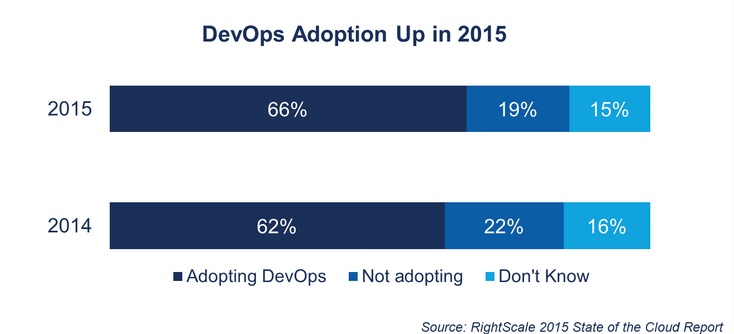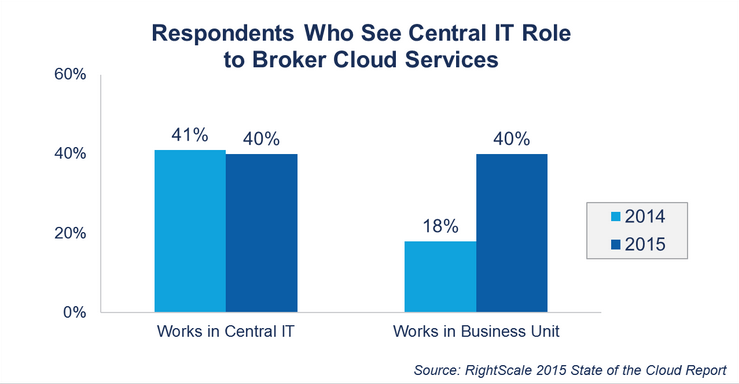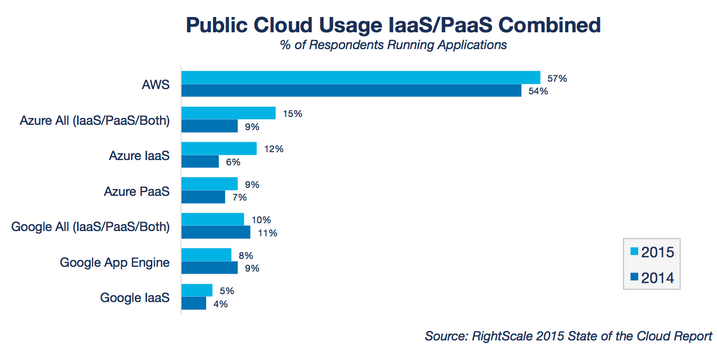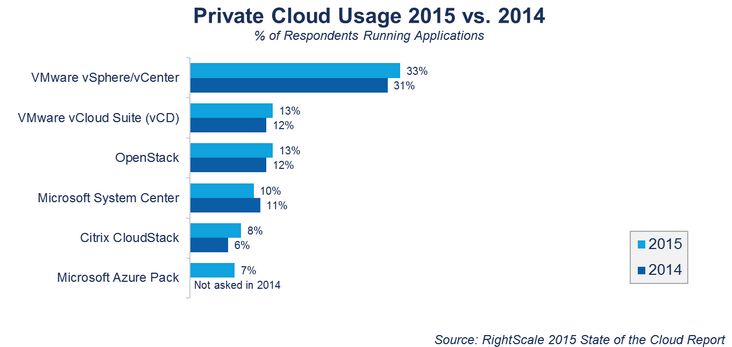In 2013, Research specialist Gartner had estimated the cloud service market to grow with a CAGR of 17.4% from 2011 through 2017, and the estimated end-user spending on cloud services to reach almost $250 billion by 2017.
Cloud Automation Vendor Rightscale, like every year, recently published its fourth annual State of the Cloud Survey conducted in January 2015. The survey was conducted among 930 IT professionals who have adopted the cloud infrastructure.
The major highlights of the report are:
- Hybrid cloud strategy went up by 74% from 2014, with 82 percent of enterprises using it.
- Almost 88% enterprises use public cloud while 63% use a private cloud.
- Around 62% of enterprises reported that Central IT is responsible for the majority of cloud spending decisions.
- 43% of IT teams are working on providing a self-service portal for access to cloud services while an additional 41% are either planning or developing one.
- DevOps are on a rise, with an adoption rate of 66%.
- While 13% of organizations are already using newbie Docker, almost 35% of organizations are planning to use.
- Azure IaaS adoption by enterprises went up to 12% from 6% in 2014. It is now second to AWS having 57% adoption by enterprises.
According to the report, 93% of the respondents are on cloud. It has been noted that public cloud services like Amazon Web Services and other vendors take the lead in adoption by organizations while private cloud leads in the number of workloads among larger enterprises. While 30% are on public cloud only, and 5% on private cloud alone; almost 58% are on both – public and private cloud. In the public cloud service category, Amazon continues to maintain its dominance. However, Azure is surely trying to make inroads among enterprises now by slowly bridging the gap in on AWS- It has 19% adoption as compared to AWS’s 50%.
Docker soars above other DevOps Tools
Ever since the advent of AWS in 2006, DevOps and cloud have been entwined together in the most intricate way. Apart from leveraging the automated configuration management tools, DevOps usually drive the continuation and releasing cycles in most organizations who use cloud infrastructure. To catalyst this driving, cloud infrastructure acts like a critical support system. However, among all other tools, newbie Docker, a container-based approach, has managed to penetrate the enterprise market at the maximum.
While there is plenty of headroom for more cloud workloads, 68% of enterprises have less than 20 percent of their workload on cloud. More than half of the respondents (55%) said they can have some 20% more applications that are ready for cloud.
Central IT teams responsible for cloud-purchase Decisions
The business models are undergoing change. Previously, enterprises were not this comfortable with cloud-based services. The decision-making was mainly taken care by small technology companies and business units that worked within a large enterprise. But now, Central IT teams are keen on taking up decisions related to cloud-purchasing.
Cloud Service Brokers gain Popularity
Another highlight of the report is the increasing popularity of cloud service brokers (CSBs). The CSBs act like an intermediary between cloud vendors and customers. Mostly there are two types- one for businesses and the other is technical. While the former act like a bridge between cloud vendors and customer, the latter takes into account services like automation, management and so on. For the first time, 40% of business unit respondents agreed that Central IT team should act as CSB, which is up from 18% in the previous year.
This huge growth also makes it challenging for companies to identify and evaluate the best cloud vendors that matches their requirement. At CloudKompare.com, we offer a platform that allows multiple service providers (130 companies signed up with us currently) to showcase their services and allow customers to compare and make an informed choice”, adds Manu.
IaaS (Infrastructure-as-a-Service) vs PaaS (Platform-as-a-Service)
In another report, RightScale dug in deep into IaaS and PaaS to find out if there is any overlap between the two, whether people are using both or either of the two, and what happens when offerings of Microsoft Azure and Google are combined.
While trying to figure out if there is any overlap between users of IaaS and PaaS (Azure and Google), it discovered:
- 70% users for IaaS, with 50% using only IaaS and 15% using any IaaS and any PaaS.
- Only 16% PaaS users, with just 1% using only PaaS.
After studying the combined usage, it was time to analyse the service providers individually. It concluded that IaaS was popular among Azure users, and PaaS among Google users. Since, there were many respondents who used both, it was a different ball-game altogether to understand which service provider out-raced the other. To make the comparison more accurate, RightScale also included AWS adoption numbers in the research. The whole analysis concluded on one major finding–
In comparison to the 57% of users running applications on Amazons, 15% were on Azure PaaS or IaaS, while 10% were on Google services. Hence, it was clear scenario- IaaS is definitely on the winning side. Both Google and Azure are reported to have seen a strong y-o-y growth of IaaS adoption as compared to PaaS.
Private Cloud becomes almost stagnant
The Sate of the cloud Survey 2015 indicated a very slight difference in the figures of 2014 and 2015 in private cloud adoption category. The show-stealer was new entry Microsoft Azure Pack, with 7% respondents already using it. However, VMware, that provides cloud and virtualization software, takes the lead with 33% respondents using vSphere as private cloud and 13% using vCloud director.
In the recent future and also ahead of that, it will be unsurprising to see IT teams making more advanced decisions based on cloud services for organizations, as McKinsey & Company has already projected the total economic impact of cloud technology to be $1.7 trillion to $6.2 trillion annually in 2025. Enterprises will be more prone to adopt cloud-based services, whether private or public. As Ms Manu Nair ends her statement saying “This wide-spread growth of cloud-based services or products is sure to challenge companies to identify and evaluate the best cloud vendors that match their requirement”, we hereby end our discussion here.






